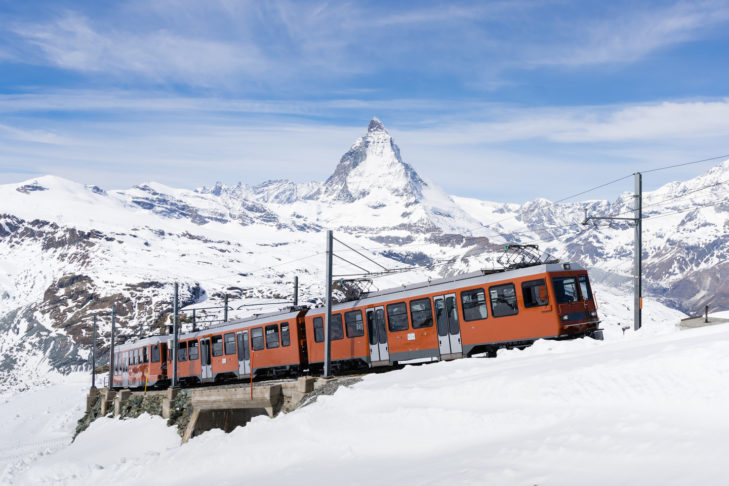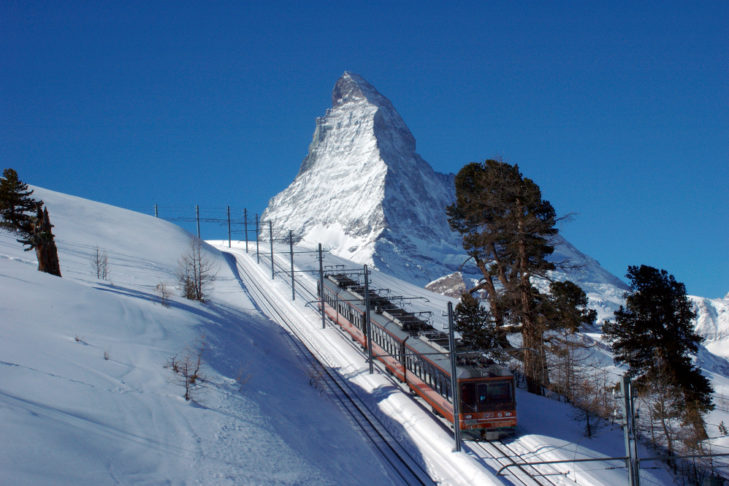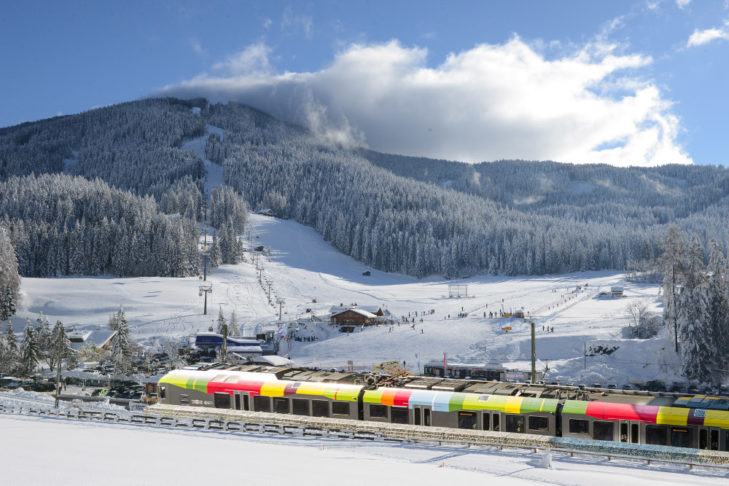Leave the car at home and travel to your skiing holiday by train – that saves nerves, time and money. Many attractive ski resorts are easily accessible by train from Germany! This is where winter sports enthusiasts can travel by train on their skiing holidays:
Advantages of travelling by train
The ski holiday is booked and we can start planning the trip. One of the first and most important questions: How do we get to the ski resort? By car, by train or even by coach? But there are many good reasons to travel by train on a ski holiday:
- No long hours behind the wheel.
- No traffic jams or blocked pass roads.
- Environmentally friendly travel.
- No expensive tolls, vignettes and fuel costs.
- Relaxed viewing of the (Alpine) landscape.
- Relaxed occupation of the children.
- Stretch your feet without having to take a break.
- No stressful search for a parking space.
- Often much cheaper than travelling by car or air thanks to special offers for groups, children and early bookers.
- No cramped sitting between pieces of luggage. (In the luggage compartments of trains serving ski regions, the storage spaces are generous).
The arguments for travelling by train are many, so here are the best ski destinations for travelling by train:
Train travel to destinations in Germany
Upper Bavaria
The Zugspitze, Germany’s highest mountain, and the Garmisch-Classic ski area are popular ski resorts for day skiers from Munich and the surrounding area. Deutsche Bahn offers a special train that runs from Munich Central Station to Garmisch-Partenkirchen in just 80 minutes. It’s a ski train with extra storage space for skis and snowboards that departs several times in the morning from around 6:30am, and at the weekend at just after 7am. This way, ski guests are on time for the lift start at Garmisch’s local mountain. The special feature of the offer: the train ticket is also the lift ticket (Garmisch Ski Ticket). After arrival, all you have to do is get off the train, walk three steps and into the skiing fun.
The Bayerische Oberlandbahn, or BOB for short, also takes winter sports enthusiasts from Munich to popular recreational areas and ski resorts such as Lenggries, Tegernsee and Bayrischzell.
Allgäu
Deutsche Bahn also travels to ski resorts such as Oberstdorf from the south of Germany. Here you can also purchase combination tickets such as the “Oberstdorf Ski Ticket” and thus use the respective trains, buses and at the same time the mountain railways and the associated ski area at favourable rates.
Train travel to destinations in Austria
Tyrol
Thanks to its proximity to the mountains, Innsbruck, the capital of Tyrol, is ideally connected. The Nordkette cable car takes winter sports enthusiasts from Innsbruck’s Hungerburg district directly to the “Nordkette” ski area on the Hafelekar (2,256 m) in just 20 minutes. The large-capacity cable car runs every 15 minutes and even leashed dogs are allowed.
With the ÖBB Nightjet you can also get to Innsbruck overnight from various places in Germany, such as Hamburg, Cologne and Düsseldorf, relaxed and well rested. It is even possible to take a car or motorbike on certain journeys. So you don’t have to do without the comfort of a car on your skiing holiday, but you arrive rested and without traffic jams in Tyrol.
Another attractive railway line is the Zillertalbahn in Tyrol. As its name suggests, it runs between the towns in the Zillertal. The starting station is in Jenbach, the terminus in Mayrhofen. This train is not only a practical means of transport through the popular valley, but also a real tourist attraction. For in addition to the diesel railcars, rustic steam locomotives also pull the carriages. Nostalgia lovers can take a stroll through the valley and even act as an engine driver themselves.
Other ski areas in Tyrol that are easily accessible by public transport include the SkiWelt Wilder Kaiser-Brixental, the Axamer-Lizum ski area, the ski area in Seefeld and the ski area in Fulpmes. The stations are usually located in the centre of the towns, which are often not particularly large, so that it is not far from the platform to the hotel or even to the slopes. Some accommodations also offer a transfer to and from the station. Furthermore, for the last few metres in many ski resorts, public transport such as buses, post buses and shuttles are available to winter holidaymakers free of charge, e.g. on presentation of a valid ski pass.
Salzburg Land & Styria
In the Ski amadé, the largest lift association in the province of Salzburg, there are no less than seven stations that offer connections to ski resorts. First and foremost is the Gastein Valley. There are stations in all three valley towns: Dorfgastein, Bad Hofgastein and Bad Gastein are served by national trains. Bischofshofen, St. Johann im Pongau and Schladming in Styria can also be reached by ÖBB trains, in some cases even with direct connections from Munich. For example, the Eurocity from the Bavarian capital takes only 2.5 hours to reach Bischofshofen. It takes 3.5 hours to get directly to the edge of the slopes of the Schladming-Dachstein mega-ski area from Munich with a single change.
Across Austria
The “Snow Express” also departs from many German cities. It starts in the very north, the departure station is Hamburg. It then stops in many German cities, including the Ruhr region, Cologne and Mainz. Finally, in Kufstein, the train splits up and serves the 17 most popular ski resorts in Salzburger Land, Tyrol and Vorarlberg. One route goes via Innsbruck, the Ötztal, St. Anton am Arlberg and ends in Bludenz. From Bludenz, you can reach Bürserberg near Boden and Brandnertal in just a few kilometres. The other route passes Kitzbühel, Fieberbrunn, Saalfelden and Zell am See, among others – in other words, only top ski regions. The final stop of the “Schnee-Express” is Schwarzach/St. Veit, right next door to Alpendorf, the direct entrance to Salzburg’s Sportwelt. The great advantage of this train is that it is a night train and you can decide whether to go to sleep relaxed in one of the couchette carriages or whether to get in the mood for the ski area with the right hits and drinks in the après-ski carriage. In addition, it is suitable for day guests, as you travel there on Friday night, spend Saturday on the slopes and can leave again in the night from Saturday to Sunday. Or you can book the return trip for the following week.
Train travel to destinations in Switzerland
Grisons
Switzerland is at the forefront when it comes to train travel to ski resorts. Almost all ski resorts and even the smallest mountain villages are well connected and accessible by public transport. In addition, there are also some car-free ski resorts in Switzerland: cars are then parked in a car park in the village beforehand, for example, and the journey continues by shuttle train or horse-drawn carriage. The best thing to do is leave your car at home and start your skiing holiday directly and relaxed by train. The best known are the special Alpine trains of the Rhaetian Railway to Davos and Klosters. The Rhaetian Railway, or RhB for short, offers several routes along Switzerland’s most beautiful mountain ranges, over bridges and through mountain tunnels to the most important ski resorts. This good train connection to many winter sports resorts sometimes even eliminates the need to change trains. For longer journeys to Switzerland, booking a seat in a couchette or travelling overnight is worth considering.
Switzerland also offers winter sports enthusiasts the Snow’n’Rail ticket, which is based on the Austrian combination tickets: when you buy the SBB Snow’n’Rail ticket, you get a 20% discount on the journey, a reduced ski pass and, on top of that, you can save 15% on rental equipment at “Intersport Rent”, so it’s a great offer for taking time out in the Swiss mountains.
Across Switzerland
The panorama train “Bernina Express”, on the other hand, starts in Chur and winds its way along the highest railway line in the Alps via Davos and St. Moritz to Tirano in Italy. The route of the “Glacier Express”, which runs on the network of the Rhaetian Railway and the Matterhorn Gotthard Railway, is even more spectacular. It runs in 8 hours from St. Moritz through the Albula Valley and the Rhine Gorge to Zermatt. Alternatively, there is a regional connection via Davos to Filisur.
The attractive route of the Matterhorn Gotthard Bahn also ends in Zermatt. The red and white train starts in Disentis (Disentis 3000 ski area) and travels via important ski resorts such as Andermatt-Sedrun, Fiesch and Täsch to Zermatt on the Matterhorn. As Zermatt is car-free, the train is also the only really practical public connection here. In total, the train covers about 144 km of track. Once you reach the Matterhorn, you have to change to the Gornergrat railway for the last stretch to the Riffelberg and Gornergrat. This cogwheel railway is the second highest railway in Europe and runs over 9 km of track to the mountain station on the Gornergrat at 3,089 m above sea level. If the views on the train journey were already great, the view from up here is simply even more gigantic!
Train travel to destinations in Italy
Val Pusteria
One of the best rail connections between Italian ski regions runs through South Tyrol’s Pustertal valley. The “Ski Pustertal Express” runs from Bressanone via Percha to Vierschach. A total of 200 kilometres of slopes can be reached via the railway line, including the popular ski resorts Kronplatz and Drei Zinnen Dolomiten. The train takes 40 minutes to travel from one valley station to the other. At Plan de Corones, you can then relax and step off the track directly into the Ried gondola lift and thus into the popular family ski area with 116 kilometres of pistes.
But to get to Italy or Switzerland first, you can use the Europa Spezial-Ticket from Deutsche Bahn. Especially for families, the train journey with this ticket is a good and cheap alternative to the car, as children under 15 travel free of charge.
SnowTrex wishes you a safe journey!
FAQs about travelling to the ski area by train
Can I travel to the ski resort by train?
Yes! Many attractive ski resorts are easily accessible by train.
Will my ski luggage fit on the train?
Especially the trains that go directly to the ski resorts usually have extra space for ski luggage.
What are the advantages of travelling to a ski resort by train?
Many, for example: no traffic jams, environmentally friendly travel as well as relaxed occupation of the children.
Which ski resorts are easily accessible by train?
The list is huge: Zillertal, Gasteinertal, Ötztal, Zell am See-Kaprun and the Kitzbühel Alps are just a selection in Austria. In addition, there are Zermatt, Davos and St. Moritz in Switzerland, Garmisch-Partenkirchen in Germany and Kronplatz in Italy.









